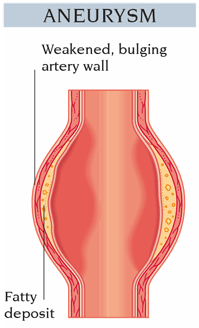AneurysmAneurism
|
Basic Information
Description
Enlargement or bulge in an artery caused by a weak artery wall. Aneurysms occur most often after a heart attack and usually affect the aorta (major artery in the chest and abdomen) or the arteries that supply the brain, legs, or heart wall.
Aneurysm signs and symptoms
 Symptoms vary according to which artery is affected:
Symptoms vary according to which artery is affected:
- Thoracic (chest) aneurysm produces pain in the chest, neck, back and abdomen. The pain may be sudden and sharp.
- Abdominal aneurysm produces back pain (sometimes severe), appetite and weight loss, and a pulsating mass in the abdomen.
- Aneurysm in a leg artery causes poor circulation in the leg, with weakness and pallor or swelling and bluish color. A pulsating mass may appear in the groin or behind the knee.
- Aneurysm in a brain artery produces headache (often throbbing), weakness, paralysis or numbness, pain behind the eye, vision change or partial blindness, and unequal pupils.
- Aneurysm in a heart muscle causes heartbeat irregularities and symptoms of congestive heart failure.
Causes
- Most common cause is high blood pressure that weakens an artery.
- Atherosclerosis (hardening of the arteries).
- Congenitally weak artery (especially with aneurysms in blood vessels to the brain).
- Infection in the aorta caused by syphilis (rare).
- Injury.
Risk increases with
- Adults over 60.
- Previous heart attack.
- High blood pressure.
- Smoking.
- Obesity.
- Family history of atherosclerosis.
- Polyarteritis nodosa (inflammation of the small and medium arteries).
- Bacterial endocarditis (infection of the heart lining).
Preventive measures
- Don't smoke.
- Get regular exercise.
- Maintain adequate nutrition and a low-fat diet.
- Obtain early treatment for syphilis.
- Follow your treatment program to control high blood pressure.
- Reduce stress.
Expected outcomes
Often curable with surgery to replace the diseased vessel with grafts (artificial vessels). Surgery on a heart aneurysm can stabilize the heartbeat and prolong life. Aneurysms sometimes recur.
Possible complications
- Stroke.
- Rupture of the aneurysm. Symptoms include severe headache, severe knife-like chest, abdominal or leg pain, and loss of consciousness. If not treated, it can be fatal.
Aneurysm treatment
General measures
- Early detection and treatment before rupture are essential.
- Medical tests include laboratory blood studies of clotting, ECG, X-rays of blood vessels (angiography), other X-rays, CT scan or ultrasound.
- Surgery to replace the diseased vessel or close off the aneurysm.
- An aneurysm to the brain requires emergency surgery. Surgery for other types of aneurysms may be scheduled at a convenient time.
- Following surgery, learn to monitor and control your blood pressure.
Medications
- Following surgery, anticoagulants to prevent bloodclot formation and pain relievers.
- Antibiotics to prevent infection may be prescribed.
Activity
Avoid heavy exertion or straining prior to surgery. After surgery, resume normal activities gradually.
Diet
Before surgery, eat a high-fiber diet so you can avoid straining during bowel movements. After surgery, no special diet is necessary.
Notify your physician if
- You or a family member has symptoms of an aneurysm, especially a pulsating mass in your abdomen or leg, or chest or abdominal pain. This is an emergency! Call for help, and rest in bed until help arrives.
- You have had a heart attack and develop heartbeat irregularity or symptoms of congestive heart failure.
- After surgery, any symptoms return.
Last updated 10 May 2016
